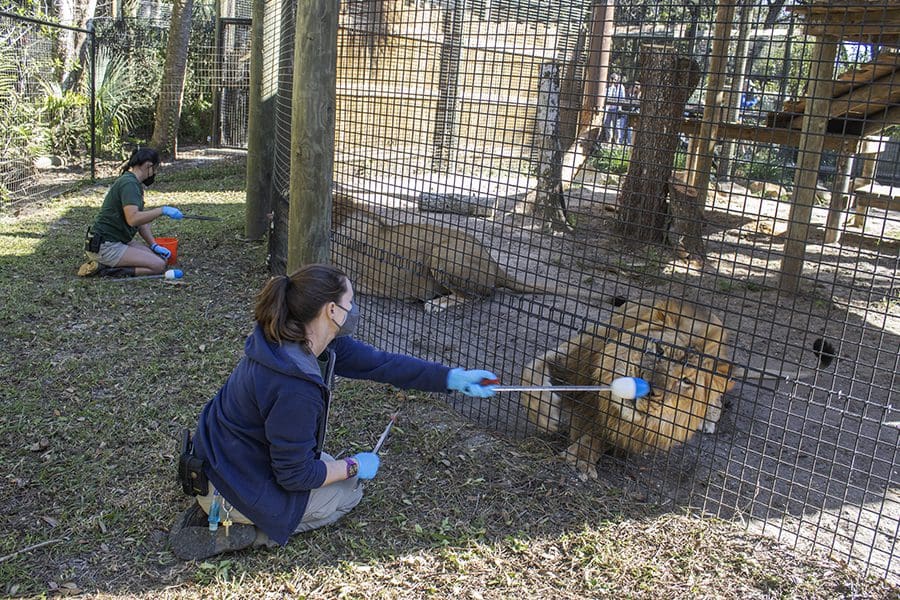

Ruaha and Karoo enjoy food rewards when they “touch” their target.
If you have pets at home, you may have trained them to do behaviors such as sit, come, or stay, or recognize their names. Training your pet is beneficial to enhancing your relationship with them, building fundamentals for more complex behaviors and caring for them on a daily basis. You might be surprised to learn that here at the Zoo, our animal care team works with all of our residents on training – whether it be tiny turtles, giant fish, energetic spider monkeys or the kings of the jungle: our lion brothers.
When lion brothers Chobe, Ruaha and Karoo arrived at the Zoo last year, they were already ahead of the game. “Their previous facility did a great job working on several behaviors with them,” said Curator of Animals Chelsea Herman. Our team first focused on building relationships with the lions and training them to shift, or move between their night house and main habitat. “We started this process by trying to ensure all interactions with their keepers and in the night house were positive, and then keepers were able to build on that positive association,” said Chelsea.
Once the brothers showed that they were more comfortable, our team began training new behaviors. But, as the age-old question goes: How do you train a lion?
Preparing the Kitchen
Our commissary department prepares the lions’ meat diets each day in individual containers. Once they’ve picked up the diets, keepers cut up the chunk meat and make the ground meat into meatballs to give the lions during training sets. Talk about a hearty snack!
Safety First
When working with any species, safety is always the top priority, for both animals and humans. Training sessions take place on the back side of the lion habitat, where keepers are able to maintain a safe distance between themselves and the big cats with a heavy-duty, animal-grade mesh separating them. In addition to wearing N-95 masks, keepers use tongs to provide the meatballs to the lions through the mesh when rewarding them for positive behaviors. They also work together to start and end the training sessions simultaneously to prevent any aggression between the lions.
The FUN in Fundamentals
Target training is a behavior that most of our animal residents are taught, and the lions are no exception. It involves using positive reinforcement to shape the behavior of an animal touching a target (usually a pole with a red ball on the end) with a part of their body (usually their nose or mouth) and rewarding them with food. “This form of training is a great fundamental behavior that can be used to shape other behaviors,” said Chelsea.
In addition to target training, the lions know a variety of behaviors including recall, sit, down, up, target and open. According to Chelsea, they are all very motivated during training sets!
Consistency is Key
Although the lions are currently living in Wild Florida, they will eventually live in a permanent home in our Expedition Africa loop, so Africa keepers work with the brothers. Because the team is so large, a few specific trainers are assigned to each lion to ensure there is as much consistency as possible during training. Training happens daily to ensure all behaviors are learned and practiced as much as possible.
The Reason Why
You now know how we train lions, but do you know why? The most basic reason is that training allows all animals to voluntarily participate in their own care here at the Zoo. Because we use positive reinforcement with all Zoo residents, there are never any consequences to animals who choose not to participate in training. If they show us they are no longer interested, training ends and we pick up where we left off at the next session.

While some of the behaviors we train the lions on are fundamentals to build off of, others directly play a part in their care. For example, the “up” behavior asks the lions to stand so that keepers can see their stomach area, which can be helpful to pick up any health concerns if they were to arise. The brothers are also trained to walk onto a scale in their night house for regular weights, which allows us to track weight trends. This information helps our staff determine the appropriate individualized diet for each lion and can help monitor overall health.
What’s Next?
“We are working on desensitizing them to different variables during their normal training sets like having Animal Curators present, and eventually, veterinary staff,” said Chelsea. “In the future, we will work on voluntary blood draws.”
As with everything that we do here at the Zoo, animal wellness is our number one priority. Training sessions are just one of the many things that our animal care staff does to ensure the health and wellbeing of our residents.
Brevard Zoo is an independent, not-for-profit organization that receives no recurring government funding for our operating costs. Your generous support enables us to continue to serve our community and continue our vital animal wellness, education and conservation programs.
